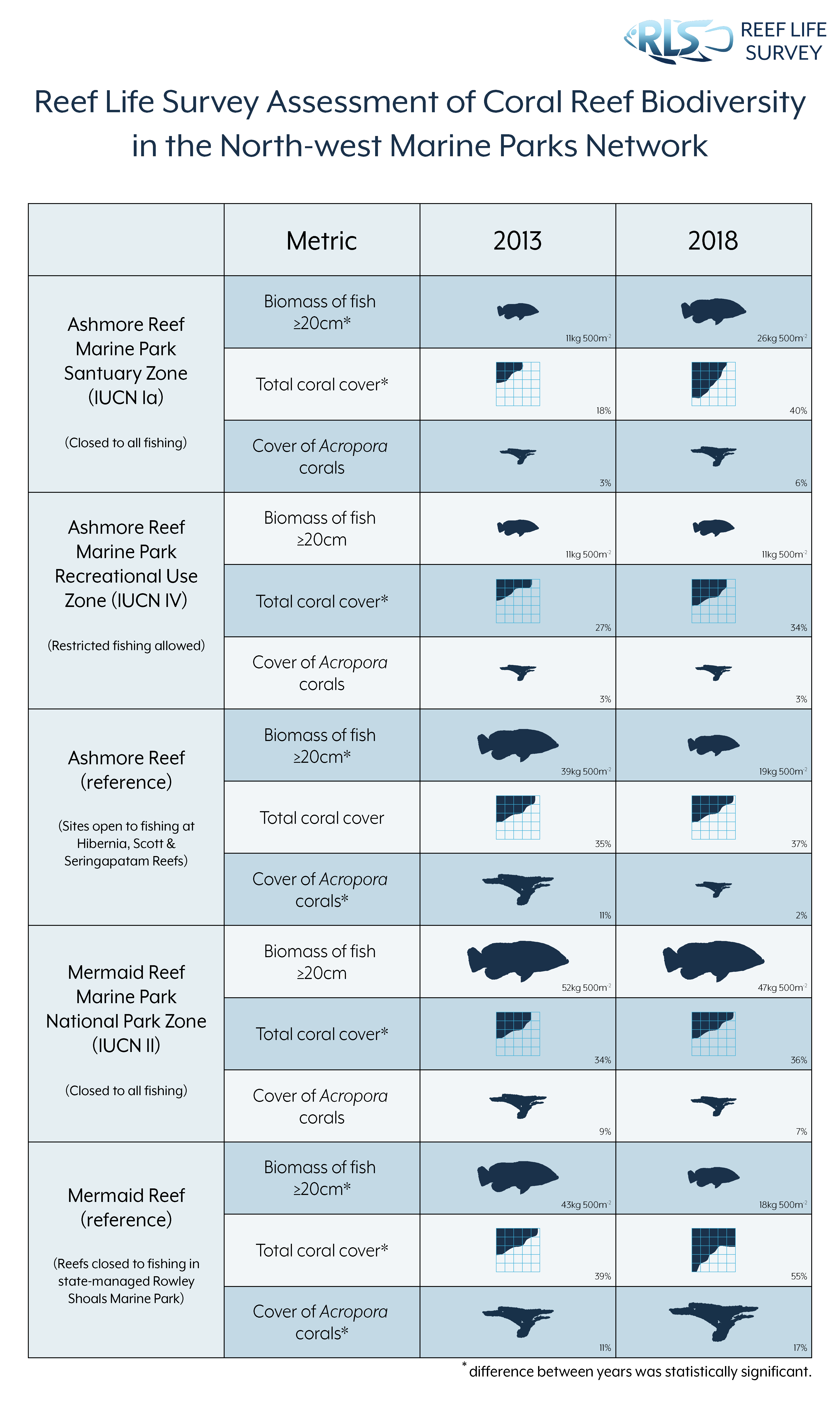Where
The North-west Marine Parks Network, which extends from the northern Kimberley to Shark Bay, off Western Australia, including remote oceanic reefs.
Who
Reef Life Survey
When
2013 and 2018/19
Why
The high species richness across the north-west marine region is likely due to the high diversity of available habitats and reefs along a gradient from the nearshore Kimberley and Ningaloo regions, to the outer edge of the continental shelf. The region is also close to the Coral Triangle, a known biodiversity hotspot.
Despite their distance from chronic human pressures that typically affect coral reefs, offshore reefs in the North-west Marine Parks Network have experienced a series of cyclones, heat stress and coral bleaching events in recent decades. Historical non-compliance with fishing regulations by fishers has also been identified as a potentially important pressure.
Monitoring surveys target the differences between reefs and between different levels of protection. They allow investigation of how coral reef communities are responding to these pressures and the management plan arrangements in place.
How
Biodiversity surveys were conducted at depths ranging from 2- 20 m, at 163 sites in 2013 and 78 sites in 2018/19. Divers laid out 50 m transect lines along the reef and systematically counted large and small fishes and mobile macroinvertebrates (e.g. sea urchins, clams, crustaceans).

Photographs were taken along each transect to record organisms growing on the substrate, such as corals, sponges and seaweeds. Repeating surveys at the same sites using the same methodologies is the most effective way to track the abundance, size and health of reef species over time. Statistical analysis then provides a means to distinguish pressure and management related patterns from the seemingly chaotic life on the reef.
What did we learn?
Surveys across the North-west Marine Parks Network in 2018 revealed that highly protected sites at Ashmore Reef Marine Park (IUCN Ia) had increased fish biomass, fish species richness, the biomass of grazing and larger (>20 cm Total Length) fishes and the density of macroinvertebrates. Many of these changes were not recorded at fished survey sites and therefore suggest a positive effect of no-take protection zones in the last five years. These results support other work in the area suggesting that the increased presence of the Australian Border Force vessels at Ashmore Reef has likely increased compliance and contributed to the recovery of previously depressed populations of large fish.

Coral communities showed signs of continued recovery, with total live coral cover and the species richness (of corals and algae) increasing throughout much of the network. Recovery was most noticeable at the survey sites within the Ashmore Reef Marine Park Sanctuary Zone. These are encouraging trends, considering cyclones, bleaching and heat stress events experienced across the region. Nearby Scott Reef suffered considerable losses of sensitive Acropora corals, but the Ashmore Reef and Mermaid Reef Marine Parks appeared to escape the impacts of the mass bleaching event in 2016.
The continued absence of sea snakes on surveys in Ashmore Reef Marine Park suggests that the decline seen between survey efforts might not be temporary, and further surveys to confirm this are required.
What next?
Ideally, ongoing monitoring of North-west Marine Parks Network reefs would continue on a regular basis using the same methodology.
Related data and publications:
Graham Edgar, Camille Mellin, Emre Turak, Rick Stuart-Smith, Antonia Cooper, Dani Ceccarelli. 2020. Reef Life Survey Assessment of Coral Reef Biodiversity in the North-west Marine Parks Network. Report to Parks Australia, Department of the Environment. Reef Life Survey Foundation Incorporated, Hobart, Tasmania.
Edgar, G. J., D. Ceccarelli, R. D. Stuart-Smith, and A. T. Cooper. 2017. Reef Life Survey assessment of coral reef biodiversity in the North-West Commonwealth Marine Reserves Network. Reef Life Survey Foundation Incorporated, Hobart, Tasmania.
Commonwealth of Australia. 2012. Marine bioregional plan for the North-west Marine Region. DSEWPaC, Canberra.
Ceccarelli, D., D. Williamson, T. Ayling, A. Ayling, and M. Pratchett. 2013. Ashmore Reef National Nature Reserve marine survey 2013 - Methods field test. Produced for Department of Sustainability, Environment, Water, Population & Communities by the ARC Centre of Excellence for Coral Reef Studies, James Cook University, Townsville.

